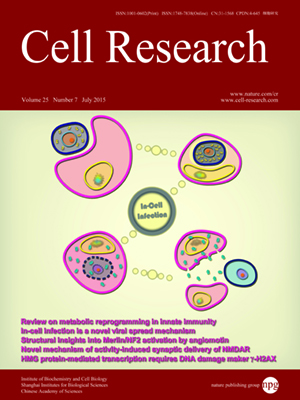
Volume 25, No 7, Jul 2015
ISSN: 1001-0602
EISSN: 1748-7838 2018
impact factor 17.848*
(Clarivate Analytics, 2019)
Volume 25 Issue 7, July 2015: 818-836
ORIGINAL ARTICLES
Activity-induced synaptic delivery of the GluN2A-containing NMDA receptor is dependent on endoplasmic reticulum chaperone Bip and involved in fear memory
Xiao-min Zhang1,2, Xun-yi Yan1, Bin Zhang1, Qian Yang1, Mao Ye1, Wei Cao1, Wen-bin Qiang1, Li-jun Zhu1, Yong-lan Du1, Xing-xing Xu1, Jia-sheng Wang1, Fei Xu1, Wei Lu3, Shuang Qiu1, Wei Yang1 and Jian-hong Luo1
1Department of Neurobiology, Key Laboratory of Medical Neurobiology (Ministry of Health of China), Collaborative Innovation Center for Brain Science, Zhejiang University School of Medicine, Hangzhou, Zhejiang 310058, China
2Department of Physiology, Kunming Medical University, Kunming, Yunnan 650500, China
3Key Laboratory of Developmental Genes and Human Disease (Ministry of Education of China), Institute of Life Sciences, Southeast University, Nanjing, Jiangsu 211189, China
Correspondence: Jian-hong Luo ; Wei Yang ; Shuang Qiu(luojianhong@zju.edu.cn ; yangwei@zju.edu.cn ; qiushly@zju.edu.cn)
The N-methyl-D-aspartate receptor (NMDAR) in adult forebrain is a heterotetramer mainly composed of two GluN1 subunits and two GluN2A and/or GluN2B subunits. The synaptic expression and relative numbers of GluN2A- and GluN2B-containing NMDARs play critical roles in controlling Ca2+-dependent signaling and synaptic plasticity. Previous studies have suggested that the synaptic trafficking of NMDAR subtypes is differentially regulated, but the precise molecular mechanism is not yet clear. In this study, we demonstrated that Bip, an endoplasmic reticulum (ER) chaperone, selectively interacted with GluN2A and mediated the neuronal activity-induced assembly and synaptic incorporation of the GluN2A-containing NMDAR from dendritic ER. Furthermore, the GluN2A-specific synaptic trafficking was effectively disrupted by peptides interrupting the interaction between Bip and GluN2A. Interestingly, fear conditioning in mice was disrupted by intraperitoneal injection of the interfering peptide before training. In summary, we have uncovered a novel mechanism for the activity-dependent supply of synaptic GluN2A-containing NMDARs, and demonstrated its relevance to memory formation.
10.1038/cr.2015.75
FULL TEXT | PDF
Browse 2154


